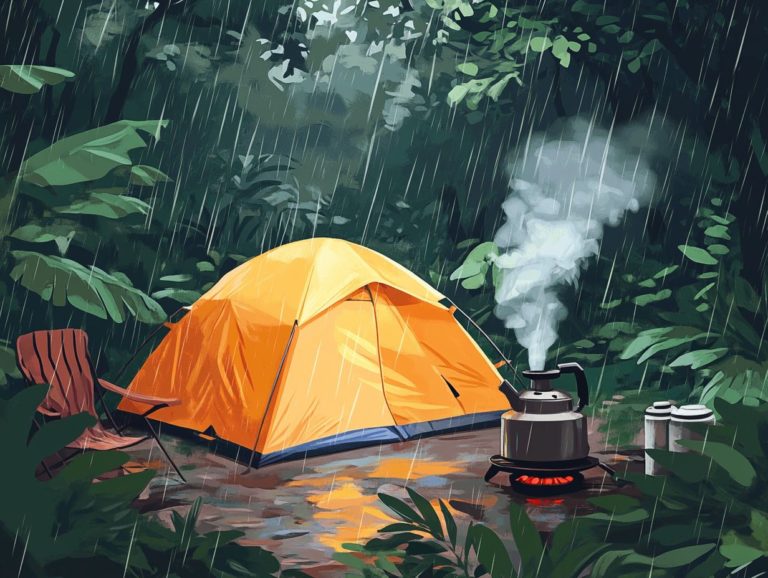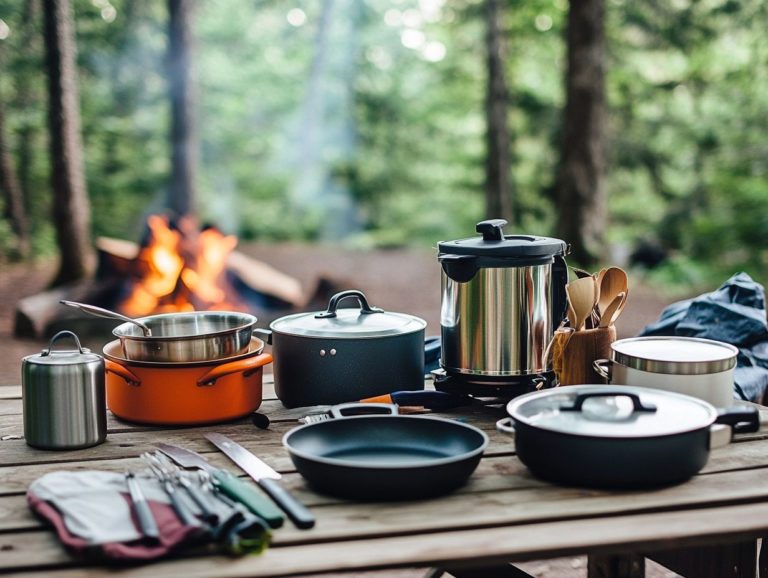How to Choose a Camping Mattress or Pad
Ready to transform your camping experience? Choosing the right mattress or pad is your first step! When planning your next camping adventure, one of the most essential elements for a restful night’s sleep is selecting the right mattress or pad.
With a variety of options available, each offering different levels of comfort, insulation, and portability, it’s crucial to understand the factors that will best meet your needs. This guide will walk you through the types of camping mattresses and pads, highlight key features to consider, and provide tips for finding the perfect fit for your sleeping style.
Whether you’re a backcountry enthusiast or a family camper, discovering the right sleeping solution can significantly enhance your outdoor experience.
Contents
- Key Takeaways:
- Factors to Consider Before Choosing a Camping Mattress or Pad
- Types of Camping Mattresses and Pads
- Features to Look for in a Camping Mattress or Pad
- Tips for Choosing the Right Size and Thickness
- Maintenance and Care for Your Camping Mattress or Pad
- Frequently Asked Questions
- What factors should I consider when choosing a camping mattress or pad?
- What types of camping mattresses or pads are available?
- Is a thicker camping mattress or pad always more comfortable?
- What size camping mattress or pad should I choose?
- Can I use a camping mattress or pad for other activities?
- How much should I budget for a camping mattress or pad?
Key Takeaways:
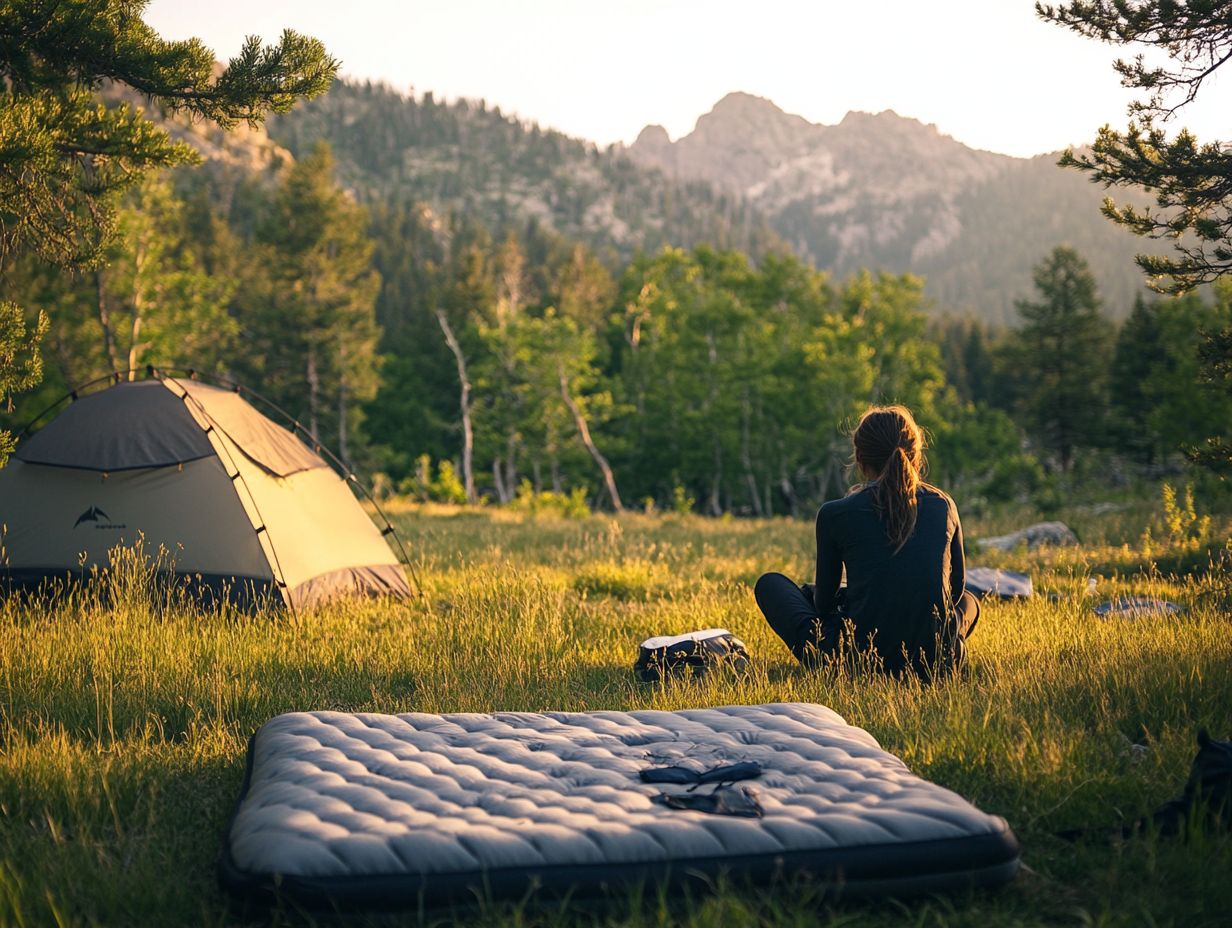
- Consider your comfort preferences and the type of camping when choosing a mattress or pad.
- Different types of camping mattresses and pads, such as air mattresses, self-inflating pads, and foam pads, each offer unique benefits.
- Pay attention to key features like insulation, portability, and durability to ensure a comfortable and lasting camping experience.
Factors to Consider Before Choosing a Camping Mattress or Pad
Choosing the right camping mattress or pad involves critical factors that enhance your outdoor sleeping experience. You ll want to understand the nuances of various types of sleeping pads, whether it s self-inflating options or closed-cell foam.
Each option carries advantages that affect your comfort, warmth, and overall satisfaction during your camping adventure. Key features include R-value, which measures insulation and keeps you warm, as well as packed size, durability, and weight reduction, especially for backpacking trips where every ounce matters.
Type of Camping and Sleeping Conditions
The type of camping you choose greatly influences your selection of a sleeping pad or mattress. For example, if you’re backpacking, lightweight and compact options prioritize portability while still offering adequate insulation.
If you re car camping, you can indulge in bulkier, more comfortable choices that deliver thick pads providing ample cushioning and support. If your adventure takes you to colder regions, focus on sleeping pads with higher R-values for superior thermal insulation.
Additionally, the ground s surface can influence your choice; rugged terrains require durable, puncture-resistant materials. Grasping the intricacies of different camping styles is crucial for optimizing your comfort in the great outdoors.
Personal Comfort Preferences
Your personal comfort preferences are essential when selecting the perfect camping mattress or pad. Factors like warmth, pressure mapping, and thermal resistance significantly impact your sleep quality.
Consider your unique sleeping style whether you re a side sleeper needing extra cushioning or a back sleeper who prioritizes stability. The latest sleeping pad technologies, including inflatable designs with adjustable firmness, offer customized support for enhanced comfort.
Features like built-in insulation help maintain an ideal sleeping temperature, particularly in cold climates. By pinpointing these personal requirements, you can make a well-informed decision for a superior sleep experience during your outdoor adventures.
Now that you know the essentials, it s time to find the perfect camping mattress or pad for your next adventure!
Types of Camping Mattresses and Pads
As you explore the diverse range of camping mattresses and pads available, you’ll discover options tailored to meet every camper’s needs. From air mattresses and self-inflating pads to closed-cell and open-cell foam pads, each type boasts distinct advantages.
Understanding these features is crucial for selecting the option that aligns perfectly with your outdoor pursuits. Air mattresses excel in comfort and packability, while closed-cell foam pads are known for their durability and insulation in colder climates. Self-inflating pads cleverly combine the best of both worlds, offering a compact solution without sacrificing comfort.
Air Mattresses
Air mattresses have become a preferred choice for campers seeking comfort without sacrificing packability. Their ability to compress into a minimal size significantly lightens your gear load.
This blend of comfort and convenience makes them an attractive option for anyone who values a restful night s sleep while exploring the great outdoors. Brands like SoundAsleep and REI provide models that offer excellent support and cushioning, equipped with quick inflation mechanisms for effortless setup after a long day of trekking.
Keep in mind that the terrain matters. While these mattresses perform admirably on flat, dry surfaces, they can struggle on uneven ground or in cooler conditions, potentially losing air more quickly than traditional sleeping pads. Such considerations can greatly impact your overall satisfaction, especially on extended camping adventures.
Self-Inflating Pads
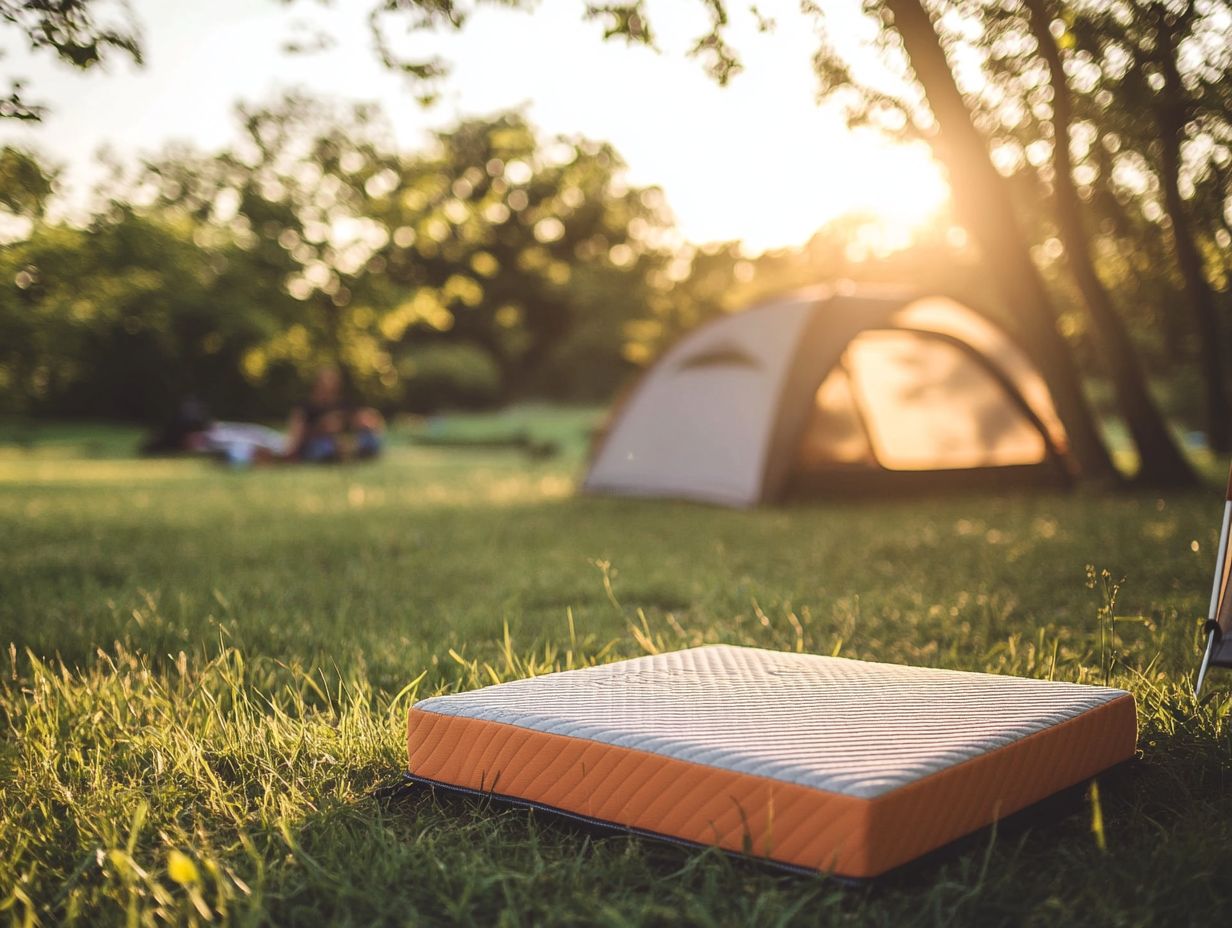
If you want to combine comfort and practicality, look no further than self-inflating pads. They blend the convenience of air construction with the comfort of foam, striking a perfect balance for campers who value both ease of use and quality sleep.
These innovative sleeping solutions simplify setup; once you open the valve, they automatically inflate, eliminating the need for manual pumping. Designed to endure outdoor adventures, they also offer exceptional insulation properties, making them perfect for backpackers seeking lightweight options and car campers craving comfort on longer trips.
Crafted from durable materials that resist punctures and weather elements, these pads guarantee a restful night’s sleep, no matter the terrain or conditions. If you re looking for comfort and practicality, self-inflating pads are your go-to choice.
Closed-Cell Foam Pads
Closed-cell foam pads are celebrated for their outstanding insulation and thermal resistance, making them ideal for backpacking in colder climates.
These pads offer impressive benefits, such as a lightweight design that allows for easy carrying without adding unnecessary bulk to your pack. Their closed-cell structure provides excellent insulation and moisture resistance, helping maintain warmth even in damp conditions.
While their durability is commendable, allowing them to endure rough terrain, keep in mind that they might not provide the same comfort as thicker pads something to consider if you find yourself sleeping on uneven ground. Nonetheless, closed-cell foam pads balance functionality and ease of use, catering to your practical needs as an outdoor adventurer.
Open-Cell Foam Pads
Open-cell foam pads offer a plush sleeping surface that elevates your comfort, enhanced by a feature that helps distribute your weight evenly to deliver optimal support and facilitate better heat transfer.
These pads conform to your body s contours, minimizing pressure points and ensuring you enjoy a restful night’s sleep, even on uneven ground. They excel in camping scenarios where comfort takes precedence, such as car camping or extended stays at established sites.
However, in more rugged conditions, you might encounter some drawbacks; their durability can be compromised by sharp objects, and they may not pack as compactly for backpacking. Understanding these nuances is essential for anyone who values a harmonious blend of comfort and functionality, giving you the power to make informed choices for your outdoor adventures.
Don t miss out on a good night s sleep while camping choose the right mattress for your needs! Consider exploring more options to find the perfect fit for your next outdoor adventure.
Features to Look for in a Camping Mattress or Pad
When choosing a camping mattress or pad, certain features are essential for a comfortable outdoor sleeping experience. Consider insulation and R-value for warmth, portability for easy transport, durability to withstand the elements, and the quality of material construction to enhance overall comfort.
Insulation and R-Value
Understanding insulation levels and R-value is crucial when selecting your camping mattress or pad. These factors significantly influence heat transfer and thermal resistance, especially across varying temperatures.
The R-value shows how well a material keeps heat. A higher R-value means better warmth during chilly nights. In colder climates, a higher R-value is necessary to prevent heat loss and ensure comfort, while in milder conditions, a lower R-value may suffice.
Being aware of how insulation performs in different situations like sleeping on cold ground versus a warm surface can greatly impact your camping experience. Ultimately, choosing the right R-value involves striking a balance between insulation performance and your specific environmental needs.
Portability and Weight
Portability and weight are crucial factors for campers, especially backpacking enthusiasts who aim to lighten their load without sacrificing comfort.
When selecting camping pads, understand that they can vary greatly in weight and packed size. On longer treks, where every ounce matters, finding a pad that balances comfort and weight can enhance your experience.
Lightweight models, often made from modern materials, fold down to a compact size, making them perfect for stowing in your backpack. These design variations lighten your load on long hikes while ensuring you can relax comfortably at the end of the day.
Explore your options and implement weight reduction strategies; these are essential components of your gear selection process, especially when considering backpacking sleeping pads.
Durability and Material
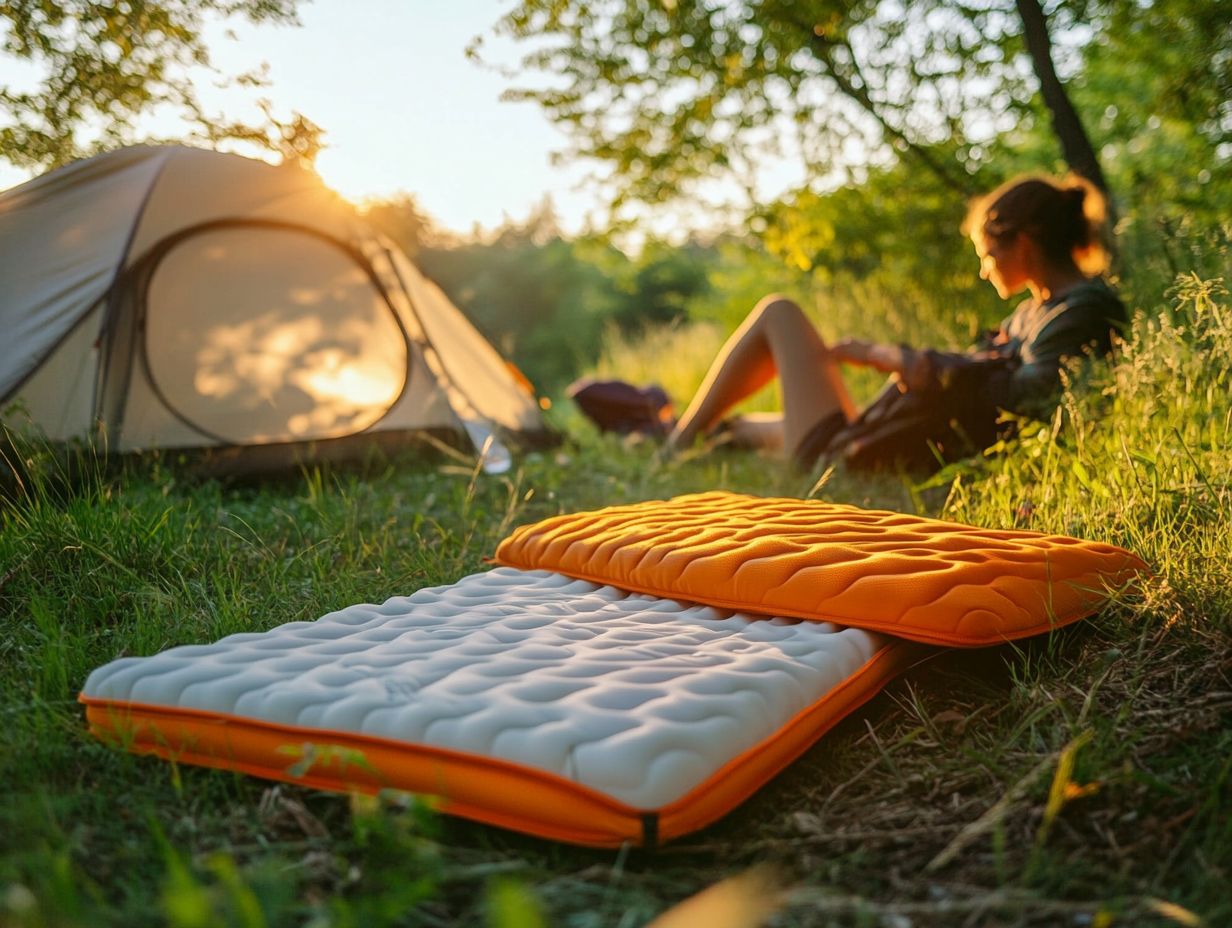
Durability is a key aspect when selecting the material for your camping mattress or pad. High tensile strength materials can endure harsh conditions and extended use, ensuring your gear lasts over time.
The choice of material greatly influences both the longevity and performance of your camping pad. For example, foam pads provide outstanding insulation and comfort but often struggle with punctures and may compress over time. Air pads typically made from ripstop nylon or polyester offer an appealing balance of weight and durability, though they can be prone to leaks if not maintained. To learn more about choosing the best option, check out this guide on how to select the right sleeping pad for camping.
As you explore your options, consider environmental factors like moisture and temperature. Some materials resist water better than others, making them more suitable for damp conditions. By understanding these nuances, you can make informed decisions leading to dependable gear for your outdoor adventures.
Tips for Choosing the Right Size and Thickness
Selecting the right size and thickness for your camping mattress or pad is crucial for achieving comfort tailored to your needs. Consider your unique sleeping style and body type to ensure a restful night’s sleep in the great outdoors.
Choose wisely to enhance your outdoor adventures!
Considering Your Sleeping Style and Body Type
Your sleeping style and body type play a significant role in determining the comfort and support of the camping mattress or pad you choose.
If you sleep on your side, a thicker, softer mattress may be ideal. It helps relieve pressure on your hips and shoulders.
Back sleepers often find that medium-firm options provide the right balance, keeping their spine aligned. Stomach sleepers should tread carefully, as too much cushioning can disrupt alignment.
If you have a heavier body type, you ll likely need a mattress that offers enhanced support and durability. This will guide you toward more robust designs. Lighter individuals should prioritize portability and weight.
Grasping these nuances is essential for selecting the perfect sleep setup for your outdoor adventures, including the right amount of air and insulation levels.
Maintenance and Care for Your Camping Mattress or Pad
Proper maintenance and care for your camping mattress or pad are essential for its longevity and optimal performance during your outdoor adventures. Taking the time to look after these essential pieces of gear will enhance your comfort and elevate your overall camping experience.
Proper Cleaning and Storage Techniques
To keep your camping mattress in top shape, clean it gently with a mild soap and water solution after each use, especially if it s been exposed to dirt or moisture.
Steer clear of harsh chemicals or abrasive materials, as these can wear down the fabric over time. Regarding storage, always roll or fold the pad loosely instead of compressing it tightly. This simple practice helps maintain its shape and prevents creasing.
Keeping the pad in a cool, dry place, away from direct sunlight, will further enhance its durability, allowing it to provide comfort and support for countless trips to come.
Frequently Asked Questions
Got questions? We ve got answers to help you choose the perfect camping mattress.
What factors should I consider when choosing a camping mattress or pad?
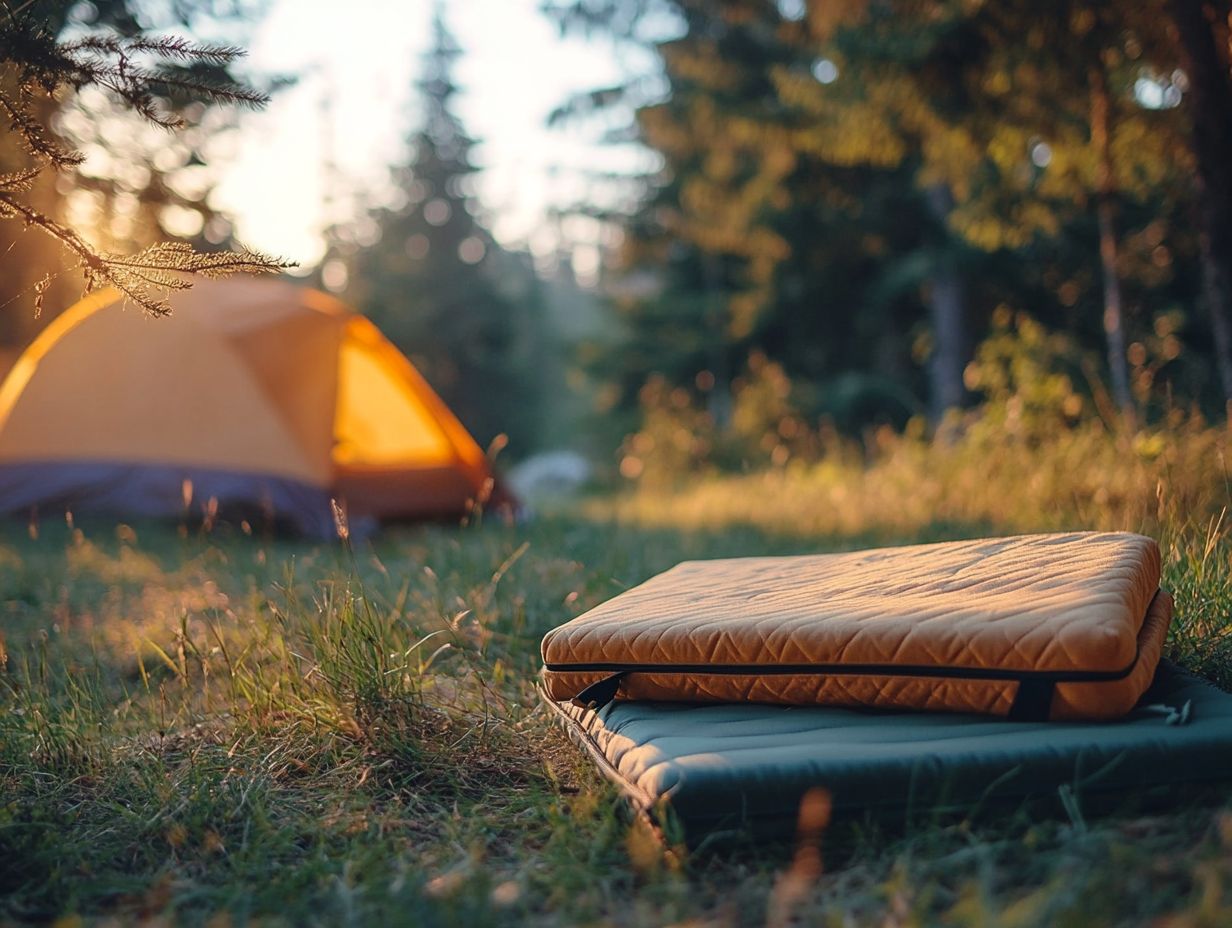
When choosing a camping mattress or pad, consider the type of camping you’ll be doing, your preferred level of comfort, the packed size and weight of the mattress or pad, and your budget.
What types of camping mattresses or pads are available?
Several types of camping mattresses or pads are available, including self-inflating air mattresses, foam pads, and air pads. Each type has its advantages and disadvantages, so it’s important to choose one that best fits your needs.
Is a thicker camping mattress or pad always more comfortable?
Not necessarily. While a thicker camping mattress or pad may provide more cushioning, it can also be heavier and bulkier. Consider your preferred level of comfort and the type of camping you will be doing before deciding on the thickness of your mattress or pad.
What size camping mattress or pad should I choose?
The size of your camping mattress or pad will depend on your personal preference, the size of your tent, and the number of people sharing the tent. Measure your tent before purchasing to ensure a proper fit.
Can I use a camping mattress or pad for other activities?
Yes, many camping mattresses or pads can be used for other activities such as hiking, backpacking, or as a spare bed for guests. Just check the weight and size to ensure it’s suitable for your intended use.
How much should I budget for a camping mattress or pad?
The cost of a camping mattress or pad can range from $20 to over $200. Consider your budget and the features you need before making a purchase. A higher-priced mattress may offer greater durability and comfort in the long run.
Choose the right camping mattress today and elevate your outdoor adventures!


